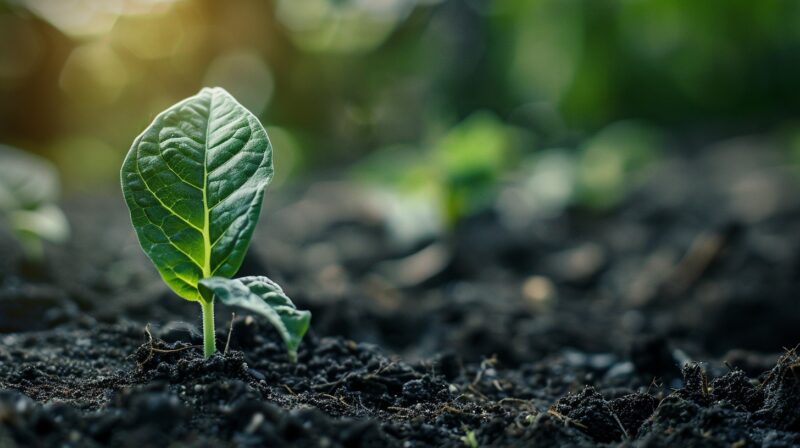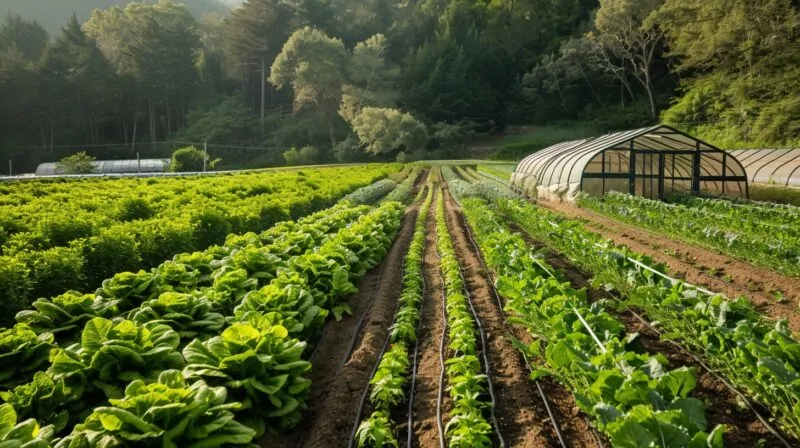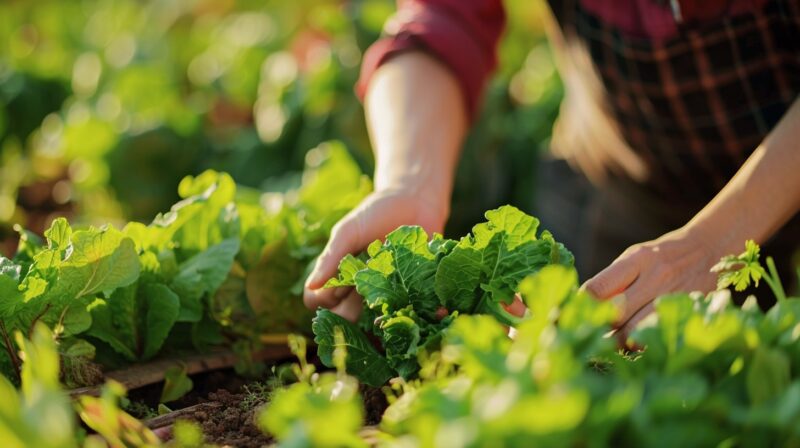Among these early proponents was Rudolf Steiner, who is often credited with laying the philosophical foundations of organic farming. By the mid-1920s, as the industrial food system was rapidly expanding, Steiner’s biodynamic approach to agriculture emerged, highlighting a holistic and regenerative approach to farming.
This method not only sought to reduce the dependence on chemical inputs but also to integrate cosmic and earthly influences within the farming process.
The evolution of organic farming continued through the 20th century as farmers and researchers alike sought to improve yields and sustainability without sacrificing the health of the ecosystem or the people it feeds.
Historical Roots
Organic farming is rooted in agricultural principles that focus on soil health and ecological balance. The early 20th century saw a shift towards this more natural approach to farming, aimed at addressing soil degradation and the narrowing diversity of crops.
Key figures such as Sir Albert Howard, who is often dubbed the father of modern organic agriculture, were instrumental in laying the foundation for organic methods. His work in India led him to advocate for composting and the integration of livestock into farming practices.
Meanwhile, Rudolf Steiner’s biodynamic farming, which emerged in the mid-1920s, presented a holistic view of agriculture that included the farm as a self-sustaining ecosystem. This concept became the precursor to what is known today as organic farming.
| Timeline | Development |
|---|---|
| Early 1900s | Awareness of soil erosion issues |
| 1924 | Introduction of biodynamic farming |
| 1940s | Widespread adoption of organic methods |
Before the introduction of synthetic chemicals in agriculture, farming was inherently “organic,” utilizing natural materials and techniques that aligned harmoniously with nature.
The defining principles of organic agriculture hold at their core the importance of healthy soils, diverse ecosystems, and a considered approach to pest control and plant nutrition that excludes synthetic chemicals. This retrogressive step back to traditional methods has been a response to the environmental and health concerns of modern agriculture.
Twentieth Century Pioneers

The early 20th century saw significant figures emerge who laid the foundation for modern organic farming. Their innovative work and dedication to sustainable agriculture continue to influence farming practices today.
1. Sir Albert Howard’s Contributions
Sir Albert Howard is often hailed as the father of modern organic agriculture. His seminal work, “An Agricultural Testament“, published in 1943, detailed his observations on traditional farming in India and advocated for organic techniques, particularly the use of compost.
Howard’s emphasis on soil health as the cornerstone of a healthy farming ecosystem remains a guiding principle in organic farming practices.
2. Rudolf Steiner and Biodynamic Agriculture
Rudolf Steiner, an Austrian philosopher and social reformer, introduced biodynamic agriculture in the 1920s. Biodynamics extends beyond organic practices by considering the farm as an interconnected living system.
Steiner’s lectures, which formed the basis of this approach, stressed the importance of the farm’s relationship with the broader ecosystem and cosmic rhythms — a concept that continues to be explored and practiced in biodynamic farms around the world.
3. J.I. Rodale and the Spread of Organic Concepts
J.I. Rodale, an American entrepreneur, played a pivotal role in popularizing chemical-free agriculture in the United States. Through the founding of Rodale Press and the publication of “Organic Farming and Gardening” magazine in 1942, he spread Howard’s principles. Rodale’s commitment to educating the public about the benefits of organic agriculture helped establish the organic food movement’s foothold in North America.
The Beginnings of Organic Farming in Iowa

Iowa saw a shift towards organic farming as a way to solve problems in the early 1900s. Farmers started trying out organic methods to make the soil healthier without using chemicals. Iowa State University helped by researching and teaching about chemical-free agriculture.
The Neely-Kinyon Long-term Agroecological Research site started in 1998. It showed how organic and regular farming are different. The Iowa Organic Association also helped farmers switch to and keep using organic ways.
Today, more and more Iowans are choosing organic farming. Customers want organic food, and farmers are committed to sustainable farming.
Post-War Developments and Movements
The decades following World War II were critical in reshaping agriculture.
Two significant trends emerged: a backlash against the intensification of agriculture known as the Green Revolution and a surge in environmentalism that fueled organic activism.
The Green Revolution Backlash
The period after World War II saw an unparalleled intensification of agriculture with the Green Revolution. This movement aimed at increasing food production through synthetic fertilizers, chemical pesticides, and high-yield crop varieties. However, the environmental and social repercussions of this initiative soon became apparent.
Paul Muller’s development of DDT in 1939, while initially hailed as a breakthrough in insect control, led to widespread concerns over chemical accumulation in the environment and food chain. In response, a critical dialogue emerged, challenging the sustainability of such chemically dependent agriculture.
Rise of Environmentalism and Organic Activism
The rise of environmental awareness in the 1960s paralleled the growth of the organic movement. Concerns about the health implications of synthetic chemicals and the degradation of the environment galvanized activists and consumers alike.
These efforts culminated with an increase in organic farms and the eventual establishment of organic standards. It was a time when the modern organic movement, as recognized today, began to coalesce into a structured philosophy and practice, advocating for an agricultural system that aligns with ecosystem health and human well-being.

Formulating Standards and Certification
The shift from traditional to organic farming necessitated clear guidelines and protocols. This led to the formal establishment of certifications and the harmonization of international standards, ensuring consumers could trust the organic label.
Establishment of Organic Certifications
During the 1970s, the concept of “organic” gained traction, necessitating a structured certification process. Early organic farmers recognized the need for standards that would authenticate their methods and produce.
In the United States, various groups of farmers began to unite around the principles of organic farming, creating localized certification programs. This framework laid the foundation for the formal certification systems that would follow.
International Organic Standards
As organic farming became more widespread, the need for an international benchmark became apparent. Organizations such as the International Federation of Organic Agriculture Movements (IFOAM) emerged to advocate for global standards.
Their efforts led to the establishment of the Codex Alimentarius guidelines for organics, which provided a steer for national regulations and facilitated international trade in organic products.
Contemporary Organic Farming

Contemporary organic farming continually evolves with advancements in agricultural techniques and consumer trends. These developments reflect a deeper understanding of ecological processes and a market that increasingly values sustainability.
Advancements in Organic Techniques
Organic farming has seen substantial growth in innovative practices designed to enhance sustainability and ecological balance. Techniques such as cover cropping and rotational grazing improve soil health and biodiversity. Integrated pest management employs a range of methods such as biological control, habitat manipulation, and the use of resistant varieties to reduce the reliance on chemical pesticides.
But the other side of the medal discovers some disadvantages.
5 Disadvantages of Organic Farming
- High Costs: Organic farming doesn’t utilize pesticides, making crops more susceptible to pests and diseases. This results in more labor-intensive practices, which increases costs. These higher production costs often lead to more expensive organic products for consumers.
- Certification Process: Obtaining organic certification is both costly and complex. Farms must be accredited by an agency like the USDA and incur initial fees of up to $1,500, plus annual certification fees based on the farm’s organic production value.
- Local Growing Systems: The success of organic farming heavily depends on the farmer’s knowledge and local environmental conditions, such as soil quality and local pest types. Lack of expertise or adverse conditions can severely affect crop yield.
- Use of Synthetic Chemicals: In some cases, organic farmers may still use synthetic chemicals if natural methods fail to prevent pest infestations, undermining the perceived benefits of organic products.
- Shorter Shelf Life: Organic products do not undergo treatments with preservatives or waxes, which means they spoil faster than conventional products. This can lead to waste if there are delays or issues in distribution.
These disadvantages highlight the challenges and implications of choosing organic products, suggesting that local purchasing might mitigate some of these issues.
Current Trends in Organic Agriculture
The market for organic products continues to expand, reflecting a growing consumer desire for environmentally friendly food options. There is a notable increase in certified organic farming acres globally, as farmers respond to higher demand.
Local and community-supported agriculture (CSA) movements have also gained momentum, promoting direct connections between producers and consumers. In addition, the rise in urban and vertical farming presents opportunities for organic production in unconventional, space-limited settings.
- The organic seed market is another growing trend, as the supply of non-GMO, organic seeds becomes more crucial to maintaining the integrity of organic farming.
Iowa as beautiful and healthy as it seems, still has some drawbacks like hornets, because of it’s diverse nature.
Final Words
The journey of organic farming from its early 20th-century roots through to the contemporary era highlights a persistent pursuit of sustainable and holistic agricultural practices.
This evolution, driven by visionary figures like Rudolf Steiner and Sir Albert Howard, has embraced the complexities of ecological balance, soil health, and biodiversity.
Today, chemical-free agriculture continues to adapt, integrating innovative techniques and responding to an ever-growing demand for environmentally conscious and healthful food options.
It stands as a testament to the enduring principles of ecological stewardship and the collective desire for a more sustainable future in agriculture.









